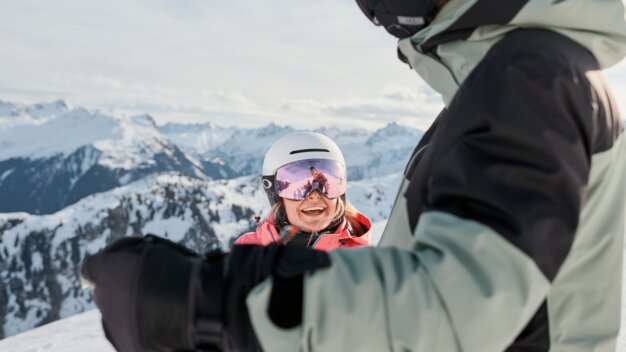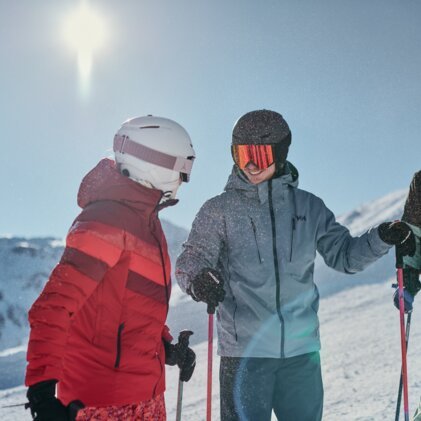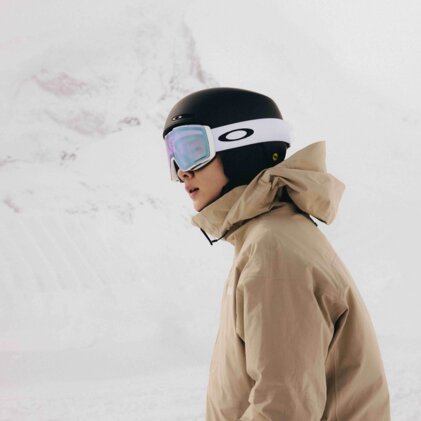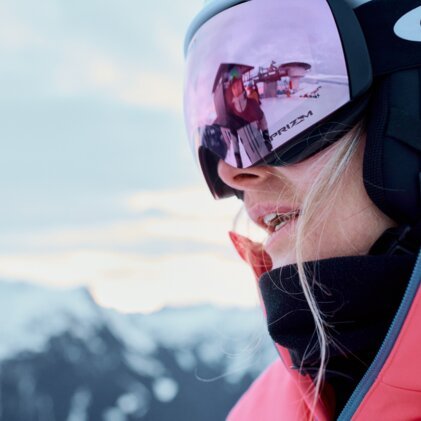
Anyone going on a winter holiday should not only wear a helmet to protect themselves from possible falls, but should also be aware of the dangers of snow blindness. After all, nobody wants to be plagued by eye pain, headaches or blurred vision on a glorious day in the snow.
Together with the ski goggle experts from Oakley, we reveal what lies behind the phenomenon. We also take a look at the symptoms of eye sunburn and how you can prevent snow blindness and protect your cornea from the sun. Let's get started!
What is snow blindness and how does it develop?
Basically, snow blindness is a sunburn on the cornea of the eye. Photokeratitis - the medical term for it - is caused by too much UV radiation. Just like your skin, your eyes are sensitive to light - that's why we blink when it gets too bright.
If too much UV light hits the cornea, the irritation can cause it to become inflamed. However, because it lies in front of the sensitive retina, the optic nerves usually remain undamaged. The higher altitude and the more intense reflection of the snow can be a particular problem for the eyes when skiing and snowboarding.
Incidentally, the intensity of UV rays increases by 10 to 20 % every 1,000 metres, which significantly increases the risk of eye sunburn.
The symptoms of snow blindness
The tricky thing about eye sunburn is that - just like a normal one - you often only notice the first symptoms and pain when it is already too late.
The first signs of snow blindness usually appear a few hours after UV exposure. These include:
- Eye pain
- Watery eyes
- Swollen, red eyelids
- Eyelid twitching
- Headaches
- Blurred vision
- Sensitivity to light
Note: Although snow blindness usually only causes minor problems, it can sometimes lead to severe visual impairment or even temporary loss of vision, depending on its severity.
How long does snow blindness usually last?
Fortunately, like sunburn, snow blindness usually heals on its own within one to two days.
Although it is not usually a serious condition, it is advisable to consult an ophthalmologist if the symptoms are severe.
First measures for the treatment of eye sunburn
Although snow blindness usually resolves itself, there are a few things you can do to alleviate the symptoms:
- Reduce sun exposure and give your eyes a break.
- Stay indoors to reduce sensitivity to light.
- Wear sunglasses to reduce exposure to the sun and UV radiation.
- Take out your contact lenses.
- Use moisturising eye drops. Special balms from the pharmacy can also help.
- Apply cold pads to your eyes.
Important: Don't rub your eyes - this will only make it worse!
You can prevent snow blindness with these options
There is only one way to reliably protect your eyes from too much UV radiation: a good pair of ski goggles or sunglasses. Models from well-known manufacturers such as Oakley offer excellent protection - and their products are absolutely worth the money!
Excessive UV exposure can lead to long-term damage to the eyes. The consequences include, for example, cataracts or eye cancer.
Did you know? Oakley's Prizm lenses block 100 % of UVA and UVB rays as well as UVC and harmful blue light up to 400 nanometres. They are available in a variety of tints and offer high contrast. Our top picks: the Flight DeckTML ski goggles and the Line MinerTM L ski goggles from Oakley.
Tip: Wear your ski goggles even on cloudy days, as UV radiation can still be high!
Frequently asked questions about preventing snow blindness
Can ski goggles prevent snow blindness?
Ski goggles offer effective protection as they greatly reduce UV radiation. Depending on the lens, they not only filter UV light, but also annoying reflections that occur on snow-covered surfaces. This prevents eye strain and reduces the risk of snow blindness. In addition, many ski goggles offer a mirrored or polarised coating, which also reduces brightness and improves contrast - another advantage in highly reflective snow. In short: good ski goggles protect against UV rays and therefore make a significant contribution to preventing snow blindness.
What helps with eye sunburn?
Firstly, it is important to keep your eyes away from UV radiation immediately - preferably in a shady or dark room to avoid further irritation of the cornea. Some cool and moist pads or just cold water can relieve the pain and calm the inflammation. Make sure that the temperature is not too low so as not to irritate the eye further. Eye drops, moisturising balms or other medication recommended by the pharmacy can also help. However, if the symptoms are more severe or do not improve, you should consult an ophthalmologist.
How long does it take to become snow blind?
Snow blindness can occur within a few hours if you are exposed to intense UV radiation. Especially at higher altitudes or with highly reflective snow, as can be the case with winter sports, the risk is much higher. Factors such as the altitude of the sun, the weather conditions and the duration of exposure play a decisive role. It is also particularly important to ensure adequate protection on days with cloudy skies or when the snow reflects a lot.
Is snow blindness only caused by snow?
No, snow blindness can occur in any environment with increased UV exposure. However, the reflections on the snow surface are particularly strong. Furthermore, those reflections can also be found on large areas of water or sand. In addition, the light from blowtorches, sunbeds or welding equipment can also lead to photokeratitis. For this reason, snow blindness is sometimes called "welder's flash".
INTERSPORT Rent tip
The RENTertainer recommends
The best way to prevent snow blindness is to protect your eyes with good ski goggles. Where can you find them? At INTERSPORT Rent, of course!
A large selection of ski goggles from leading manufacturers, which all offer excellent UV protection, awaits you in our 800+ rental shops. Simply drop by and get advice from our RENTertainers on site. Ideally, bring your ski helmet along. Otherwise, if the ventilation systems of the goggles and helmet are not compatible, the goggles may fog up.
Related articles
You may also be interested in:



